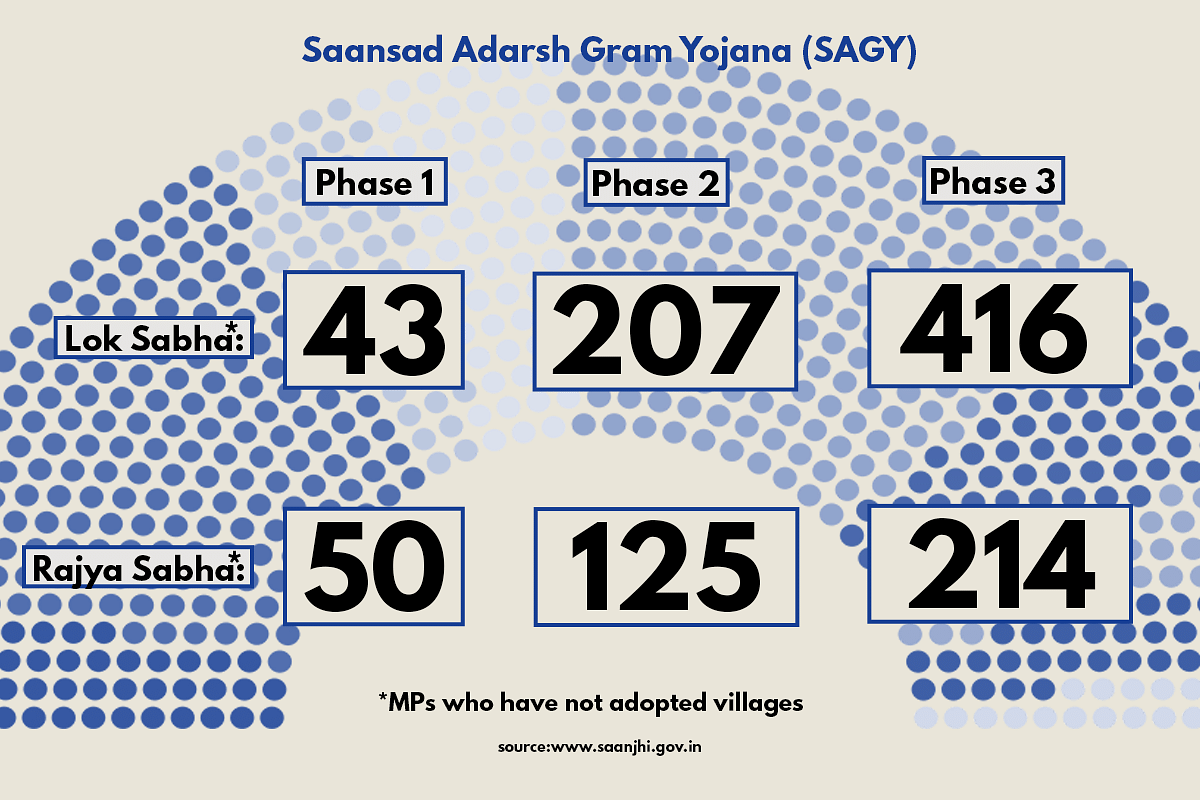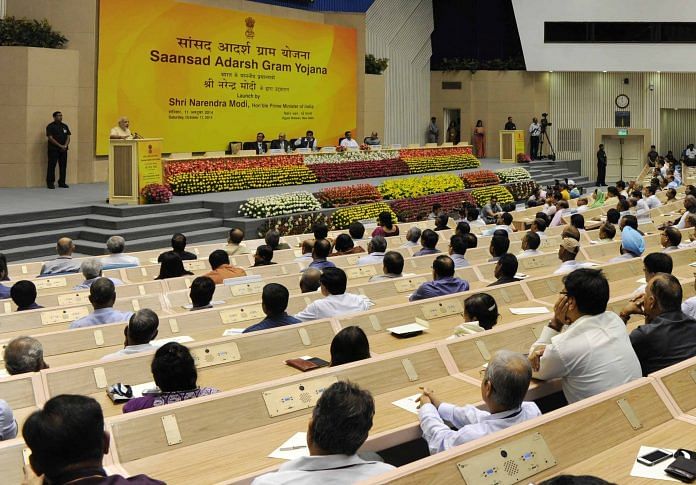416 Lok Sabha MPs and 214 Rajya Sabha MPs haven’t adopted a village under the third phase of the scheme, which was to be implemented by 2019.
New Delhi: Prime Minister Narendra Modi’s Saansad Adarsh Gram Yojana (SAGY) is clearly far from being an ‘adarsh’ or ideal scheme. An increasing number of MPs have given it a big thumbs-down, and refused to adopt villages under it.
The scheme was considered important, given Modi’s personal backing — he announced it in his first Independence Day speech in 2014, and launched it later that year, going on to adopt a village in each of its three phases. This scheme was also a crucial part of the Modi-led government’s efforts to give itself a pro-rural, pro-welfare image to counter its rivals’ charge that this was a government for the rich.
However, according to official data, as many as 416 Lok Sabha MPs and 214 Rajya Sabha MPs haven’t yet identified villages to be adopted under the scheme in the third phase.

As an indication of the growing disdain for the scheme among MPs and its hugely reduced political clout, the number of legislators sitting out has seen a steady and sharp increase in both Lok Sabha and Rajya Sabha. In the first phase, only 43 Lok Sabha MPs and 50 Rajya Sabha MPs didn’t sign up for it, while in the second phase, the number had gone up to 207 in the Lok Sabha and 125 in the Rajya Sabha.
Interestingly, given the fact that the BJP is now the single largest party in both the houses, it is clear that a sizeable number of BJP MPs have also not reposed their faith in this project.
Basics of the scheme
Under SAGY, each Lok Sabha MP has to adopt a village (gram panchayat being the unit) in her/his constituency for all-round development using existing resources and rural schemes as well as her/his MPLADS fund. Rajya Sabha MPs can select a village in any district of the state from which they have been elected.
Each MP is free to identify any village to be developed as a ‘model village’, except his or her own village and that of his/her spouse. As per the target, every MP was to develop one village by 2016 and two more by 2019.
Senior officials in the rural development ministry, who did not wish to be identified, said there is still one year to go, and some more MPs could yet adopt villages in the third phase. However, developing a village requires a significant period of time, and there’s very little time left to do that, especially in villages that have still not been adopted in the third phase.
Officials also claim this reluctance by MPs was not much of a surprise, given the complaints that were received after villages were adopted in the first phase.
MPs’ criticism of the scheme
The most glaring issue with this scheme is that it has no funds allotted to it; MPs are merely expected to use their MPLADS funds as well as ensure more effective utilisation of funds for existing rural schemes. This has made it difficult for MPs to take any concrete steps or make a serious difference, and meet the expectations of the chosen village.
“There is no scheme. It is just a nomenclature. There is no money backing the scheme to ensure development in the adopted village. The PM has said MPs must ensure all rural schemes are implemented effectively in that particular village, which means if I focus on one such panchayat among the 550, I deprive the other 549,” said Kalikesh Narayan Singh Deo of the Biju Janata Dal.
“Unless there is money backing the scheme, it is difficult to get excited about it,” said the MP for Bolangir in Odisha, who adopted villages in the first two phases but dropped out of the third phase, calling it a “pointless exercise”.
Some MPs believe the scheme is poorly planned, and shows “lack of experience in governance”.
“When you say Saansad Adarsh Gram Yojana, public perception is it will turn the village into paradise. But when you look deeper, this exercise just depends on me as an MP making sociological and behavioural changes in the village, and requires my individual intervention,” said Sushmita Dev of the Congress.
“As politicians, we are all very busy. If I spend so much time in one village, how am I positioned with respect to the other villages in my constituency?” asked the MP for Silchar, Assam, adding that the scheme needed to ensure an “additional allocation” for the adopted village. Like Singh Deo, she adopted a village in the first two phases but hasn’t in the third.
“Also, if I adopt a village, I will pick the most remote and deprived one. This means it will be far away from the headquarters. Under the scheme, there should have been a nodal officer in each state with enough human resources to take care of it. This is a classic example of Narendra Modi selling a narrative, but with no basis. Its very foundation is flawed. This shows complete lack of experience in governance.”
BJP MPs’ blame game
BJP MPs, meanwhile, offer their own explanations for not picking a village.
“I don’t know about other MPs, who may have their own reasons, but I did pick a village in the first phase. However, what happened was that the state government did not cooperate at all,” said S.S. Ahluwalia, the MP for Darjeeling, West Bengal, where Mamata Banerjee’s Trinamool Congress is in power.
“No work happened in that village since officials refused to cooperate. At the end of the day, it isn’t MPs who will implement the scheme, but local authorities. After that, I thought what is the point in picking another village.”
Suspended BJP MP Kirti Azad also blamed the state government, in his case the Nitish Kumar administration in Bihar.
“The chief minister (Nitish Kumar) has started the ‘Saat Nishchay’ programme and has diverted all funds to that. When you talk about adarsh gram, you talk about the development of 65 various schemes under central government. But unfortunately, since money is only going into Saat Nishchay mission, no work is taking place,” said the Lok Sabha member for Darbhanga.
“Even the work we gave in the first village isn’t complete yet,” said Azad, also underlining the need to raise money under MPLADS to deal with fund shortage.




The most laughable argument is about being busy all round the year. May I ask – busy in what? MPs are suposed to give inputs of their constituency when debating a bill. For how many days does parliament function? How many bills get passed in a year? And infact even if one is to take an idealistic scenario of most efficient functioning of parliament, it’s the cabinet – the ministers who are at the center of bill making exercise. I am not even arguing yet about MPs of opposition parties, and whatever they be up to. The SAGY was from the very start about creating ideal administrative and socio-economic reforms at teh ground level in few villgaes which may spread the same new standards to surrounding villages. If it was just about more funding, then what were the MPs supposed to do? Cut ribbons? But the MPs seem to not like any kind of work at all. These are the most lethargic public servants you can come across.